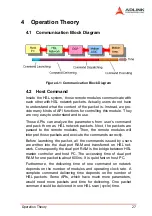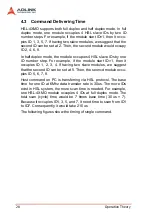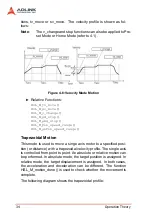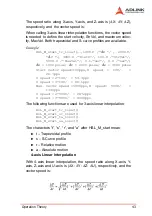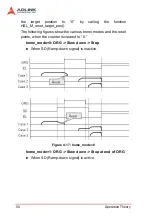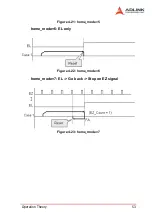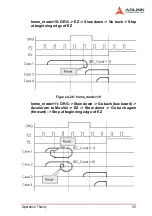
Operation Theory
41
Figure 4-11: 2 Axes Linear Interpolation
The speed ratio along X-axis and Y-axis is (
∆
X:
∆
Y), respectively,
and the vector speed is:
When calling 2-axis linear interpolation functions, the vector speed
needs to define the start velocity, StrVel, and maximum velocity,
MaxVel. Both trapezoidal and S-curve profiles are available.
Example:
HSL_M_start_tr_move_xy(0, 30000.0, 40000.0, 1000.0, 5000.0,
0.1, 0.2) will cause the XY axes (axes 0 & 1) of Card 0 to perform
a linear interpolation movement, in which:
∆
X = 30000 pulses;
∆
Y = 40000 pulses
Start vector speed = 1000pps, X speed=600pps, Y
speed = 800pps
Max. vector speed = 5000pps, X speed=3000pps, Y
speed = 4000pps
Acceleration time = 0.1sec; Deceleration time =
0.2sec
There are two groups of functions that provide 2-axis linear inter-
polation. The first group divides the 4 axes into XY (axis 0 & axis
1) and ZU (axis 2 & axis 3). By calling these functions, the target
axes are already assigned.
HSL_M_start_tr_move_xy()
HSL_M_start_tr_move_zu()
HSL_M_start_ta_move_xy(
Summary of Contents for HSL-4XMO
Page 4: ......
Page 16: ...6 Introduction ...
Page 36: ...26 Signal Connections ...
Page 67: ...Operation Theory 57 Home Search Example Home mode 1 Figure 4 29 Home Search Example ...
Page 108: ...98 Motion Creator in LinkMaster ...

